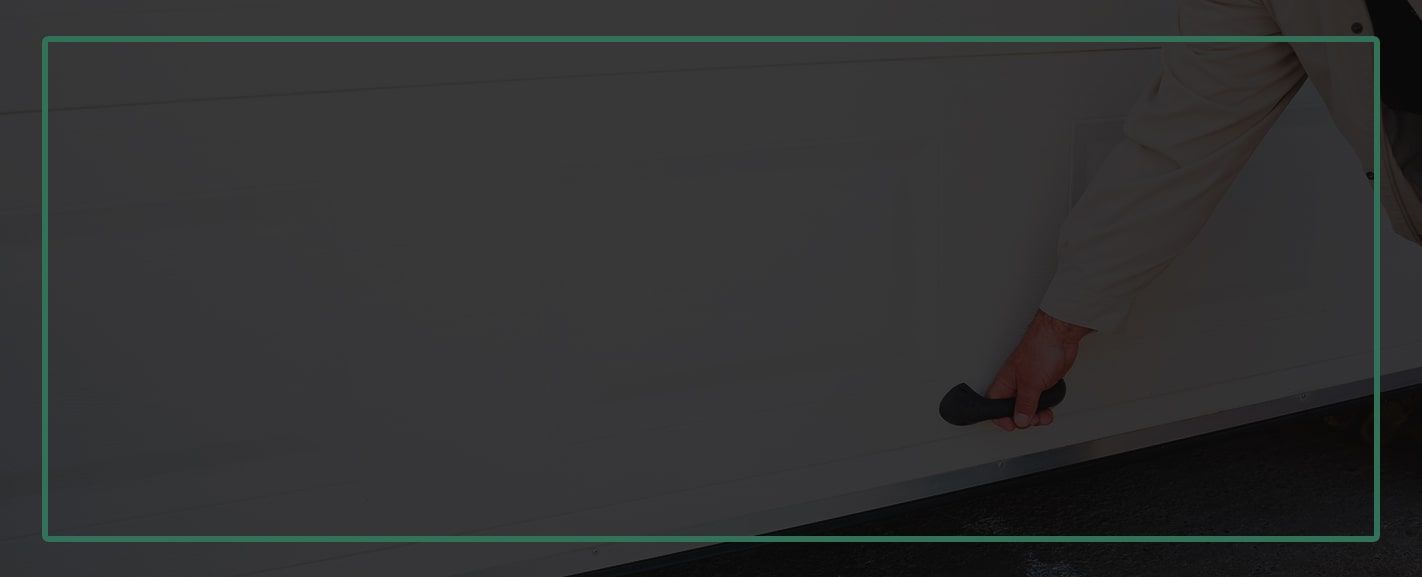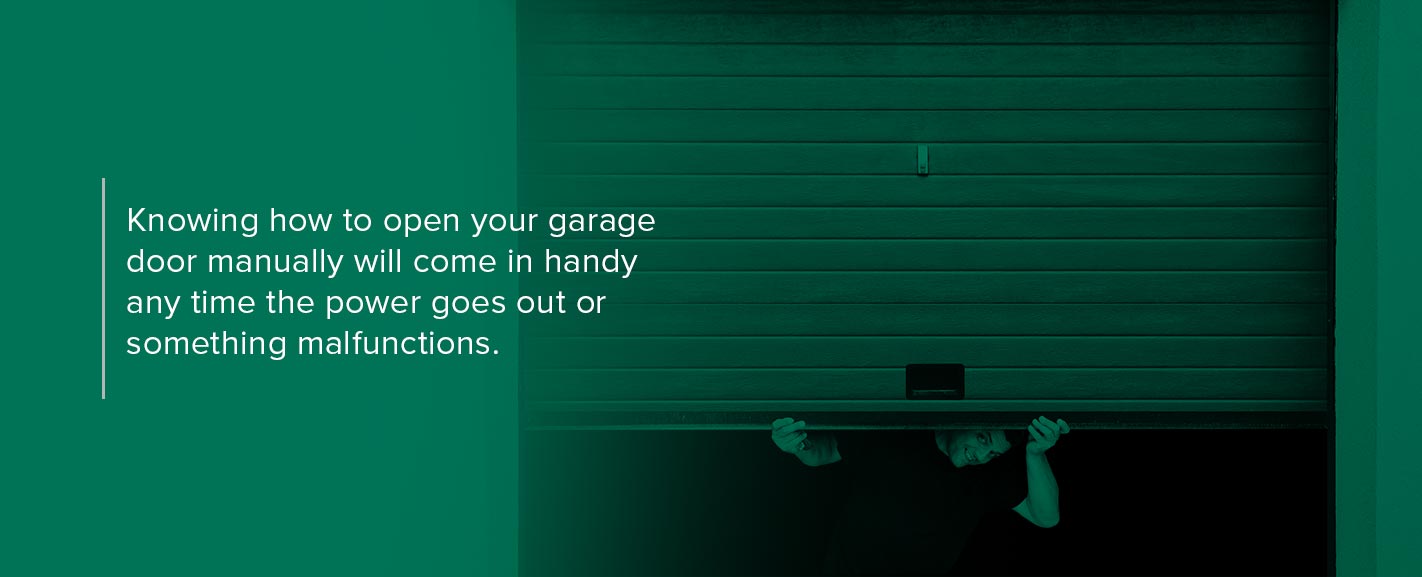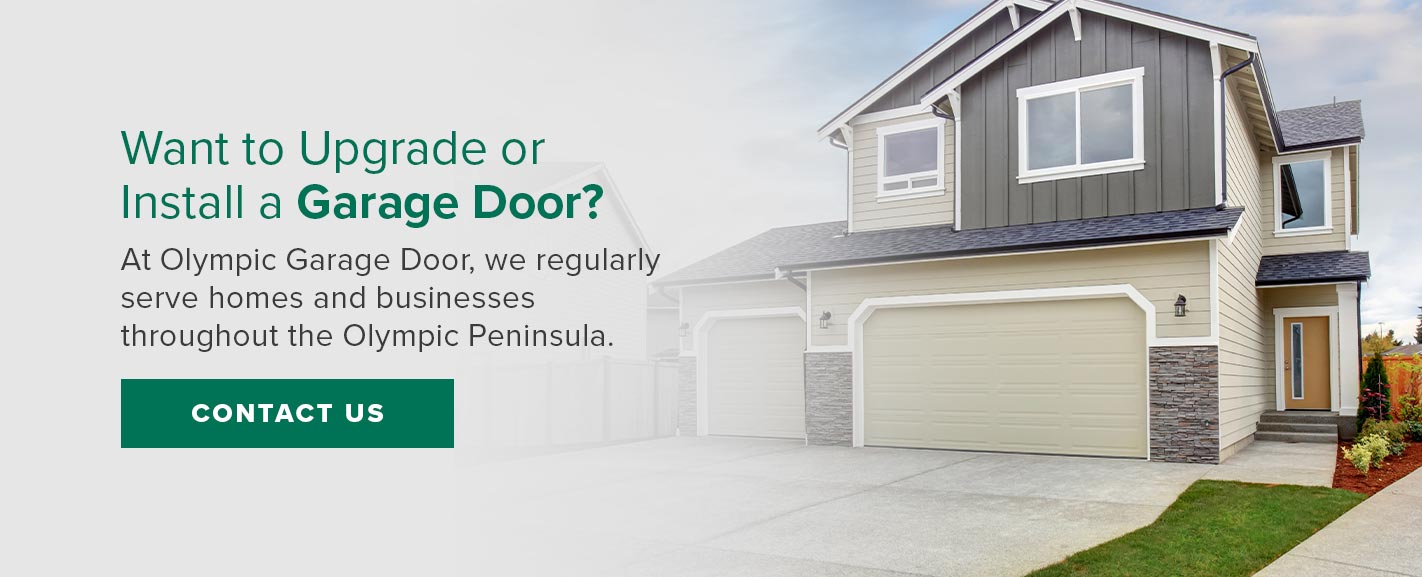How to Open a Garage Door Without Power

Coming home to a non-functioning garage door can be incredibly frustrating. Whether it’s a dead battery in your remote or a power outage, you should know how to open and shut your garage door manually. You don’t want your vehicle to get stuck in the garage, unable to leave, while you wait for a maintenance specialist. To open the door successfully, you’ll need to know the common causes, standard procedures and safety tips to open a garage door on your own.
- Electric Garage Door Stopped Working
- Can You Open A Garage Door Without Electricity?
- Steps To Open Your Garage Door With No Power
- Alternative Methods For Opening A Garage
- How To Safely Open Your Garage Door Manually
- Want To Upgrade Or Install A Garage Door?
11 Common Reasons Your Electric Garage Door Stopped Working
If you find you can’t open your garage door from the outside, you’ll need to figure out what is causing the issues. Before you try to open it manually, run through the common reasons why a garage door stops working to make sure you can safely open it on your own.
1. The Photo Eye Is Damaged or Dirty
Many garage doors have a photo eye that rests about four to six inches off the ground on both sides of the garage. Photo eyes are a safety precaution to keep garage doors from closing on someone or something. These photo eyes send a laser across the garage to one another.
If something interrupts this laser transmission, the garage door will not close. Therefore, make sure there is nothing obstructing either photo eye. Also, check if the cord to the photo eye is cut or damaged. Additionally, one or both eyes could have dirt or dust on them, blocking the laser from properly transmitting. If this is the case, a quick cleaning can fix this issue.
2. Broken Torsion Springs
One of the most common sources of a garage door needing repair is a spring breaking. You’ll often hear a loud snap or something that resembles a firecracker going off when the spring breaks. If a spring breaks, you should wait for a professional to repair it, and you should not try to open the garage door on your own.
3. Snapped Cable
When a torsion spring breaks, the garage door cable will often snap off with it. A snapped cable can cause significant damage and requires an in-depth, professional repair job. As with broken torsion springs, opening the garage manually could be dangerous.
4. Disconnect Switch
A garage door opener will almost always come with a disconnect switch that lets you open the door manually. If you’ve accidentally activated the switch, the motor will disconnect, so you’ll want to check if this is the case. If so, reattach your disconnect switch to the motor and test opening the garage with your transmitter.
5. Disrupted Power Source
Occasionally, the problem is not with the door but with the power source connected to the door. Make sure you have your garage door opener plugged into a working outlet. You’ll also want to check your GFCI, fuse and circuit breaker.
6. Malfunctioning Remote Control
Sometimes, there is a problem with the remote control. The issue might be that you’re out of range, or the battery could be dead. To test if your remote control is dead, press the transmitter button on the wall inside your garage. If the door still opens and closes with this button, that is a sign your remote is the issue. Luckily, fixing this issue usually just requires replacing your remote’s batteries.
Also, you may need to reprogram the remote. Check to see if the antenna on the garage’s motor has gotten damaged or if something could be blocking it.
7. Transmitters Not Working Correctly
Your garage door transmitter and remote work within a specific range. If you are out of this range, your garage door cannot open. It’s best to wait until you are in your driveway before trying to open your garage. If you still experience problems opening your garage door, you may need to reprogram your transmitter.
Reprogramming your transmitter may look slightly different depending on your model, so it is best to locate your owner’s manual and follow the directions. Generally, you will need to find the learn button on the remote and hold it until it starts blinking. From there, press the remote button again to reconnect your transmitters.
8. Incorrect Limit Settings
While limit-setting issues are more common for new garage doors, this problem can happen regardless of how long you’ve had your garage door. When your garage door’s limit settings are set incorrectly, the opener misunderstands the distance it takes for the door to open or close fully.
If the door’s limit settings are too high, the door will think it has hit an obstacle instead of hitting the ground. As mentioned earlier, if the door thinks it’s hit an object, it will stop closing and begin to open back up to avoid causing injury or damage. Use your owner’s manual or call a professional technician to adjust your limit settings.
9. Door Is Not on Its Track
A door needs to be on track to slide properly. Check to see the door rolls smoothly on the metal track. You should also look for any alterations along the track, like bumps, obstacles or gaps. To fix this, you’ll need to loosen the screws for the tracks, tap the track into the right position, then re-tighten the previously loosened screws.
10. Manually Locked Door
Occasionally, a garage door that isn’t working has a very simple solution. A garage door can be manually locked, so you’ll want to see if someone has accidentally engaged the lock mechanism. Find your manual lock and turn the handle until there is a click, then secure this manual lock in the open position. If you’re having trouble finding or manually unlocking your garage door, refer to your owner’s manual.
11. Unseen Obstacles
If you have trouble closing your garage door, it may be due to something on the tracks or in the way of the laser. If your door begins to open or close but then stops and reverses, you can assume something is blocking the door’s path. Look for any obstacles and wipe down the track to dislodge any dirt or debris that might be in the way.

Can You Open a Garage Door Without Electricity?
If you can’t figure out why your garage door is not working after a power outage, you can still open it without electricity. Knowing how to open your garage door manually will come in handy any time the power goes out or something malfunctions. To open up a garage door on your own, you’ll need to take the necessary precautions.
People can generally complete this job on their own, but safety should always be your top priority. If the garage door is heavy, you may want to bring someone along to assist you as you pull the gate up so you don’t hurt your back.
Learning the proper steps to safely open your garage door manually will be a big help, as you’ll want to be able to get your car out of the garage to get to work. On the flip side, if the power’s out due to inclement weather, you’ll want to get your vehicle inside to protect it, so it’s crucial you know how to manually open a garage door when the power is out.
Steps to Open Your Garage Door With No Power
If you need to know how to open a garage door without power, you’ll want to follow the below steps to give yourself access to your garage again.
Opening Your Garage Door From the Inside
Follow these steps to open your garage door manually from inside the garage:
- To begin the process, you’ll first need to make sure all the springs or cables are intact, along with ensuring there hasn’t been any damage to the rest of the garage door system. If the garage door is damaged, you might end up harming it more in the process. Along with damaging the garage, a broken cable or spring could hurt you. If you do find any issues with the garage door, it will be best to call a professional to make the repairs or open the garage.
- Once you’ve verified there are no problems that require a more in-depth repair, you’ll want to find the emergency cord. This cord usually comes with a red handle attached to it and will hang from the center of the garage door mechanism. If there’s not a red cord, but there is a cord hanging from the center of the garage door mechanism, it’s likely the emergency cord. You will probably need a ladder to reach the cord.
- You’ll want to pull the cord until the lever locks into a down position. It will cause the release lever to disengage from the carriage of the garage door opener. By releasing the lever, you’ll now be able to move the garage door without any electrical assistance.
- With the lever released, lift the garage door. If the door still won’t open, double-check that you pulled the emergency cord hard enough. Fully open the door until you can no longer move it back away from the entrance.
- If the garage door does not lift easily from the ground, you’ll want to have a professional examine it to see if there’s any damage that could represent safety risks. A smooth opening will indicate the springs are balanced correctly, and you can be confident you aren’t harming your garage door by manually opening it.
- Once the door is completely open, you will want to secure it by using something like a two-by-four to prop the door up, or have someone hold the door open so you can drive your vehicle in or out of the garage, whichever suits your needs. You can then carefully close the door in the same way you opened it.
- After regaining access to your garage, you will want to reconnect your garage door to the automatic door opener. To do this, you’ll need to use a long stick, like the end of a broom, to push the lever upward. You can also climb a ladder and press it up. Along with these methods, you can also ensure the mechanism re-engages by pulling the cord towards the door motor. You’ll need to pull the release cord until you hear the mechanism click in place.
Opening Your Garage Door From the Outside
It can be more challenging to open the door from the outside, but it’s still possible. Follow these steps:
- First, you will need to locate the emergency release kit. This kit looks like a box that protects wires. You will need a key to access this kit. If you do not have the key and cannot open the garage from the inside, you will need to call a professional technician for help.
- Use the key to unlock the kit. Doing so will trigger the door to disconnect from its electrical mode.
- Now that the door is in manual mode, find the handle on the door. This handle may need a key to be activated. The same key used for the emergency release kit can be used for this handle too.
- Physically open your garage using the handle.
- Reconnect the garage door to its automatic function as listed above.
If your garage door is partially open, do not pull the emergency cord. Doing so will release the door with so much force, it will damage the door and anything in its way.
Alternative Methods for Opening a Garage
If for some reason your garage door won’t open even with the emergency release cord, you’ll need to go through a detailed process.
- First, find the door opener carriage assembly, then remove the cotter and clevis pins from it. You may need a ladder to reach them safely.
- By removing the pins, you’ll now be able to lift the door, as it’s disconnected from the garage door mechanism.
- If you can’t reach the door opener carriage assembly, you can go to the door arm bracket attached to the door by removing the cotter and clevis pins.
- Like removing the pins from the door opener carriage assembly, the door will now be separate from the garage door mechanism, and you’ll be able to lift it manually. If you take it from the door opener carriage assembly, you’ll want to be careful with the door arm as you lower it to ensure you don’t damage it.
How to Safely Open Your Garage Door Manually
Along with the above steps, there are a few safety precautions you should follow to ensure you stay safe while you manually open the garage door.
1. Disconnect Power Cord
Even if your power is out, you should still disconnect the power cord from your garage door opener. Take this step before you do anything else to open the door manually. It’s essential to ensure no power is running into the opener that could harm you while you attempt to remove anything from the garage door’s mechanisms.
2. Don’t Operate a Damaged Garage Door
If your garage door no longer opens due to damage, you will not want to try to open it by yourself. In this case, you’ll need to call a professional to assist you. For instance, if your garage door has glass windows that have shattered, you won’t want to open the door even if it is fully functional, since broken glass could fall on you or your vehicle.
3. Read the Manual
Your owner’s manual might contain some crucial information about operating your garage door manually. While some general steps apply to most garage doors, you should still check to see if your door differs from the norm.
By looking at the manual, you might discover removing a part could harm your garage door or cause an issue that could make you and your family less safe. Understanding the traits of your garage door will help you stay safe and protect your investment.
4. Don’t Ever Fix Cables or Springs by Yourself
While it’s not dangerous to remove the cotter or clevis pin from your garage door, you should not attempt to fix any cables or springs by yourself. A mishandled cable could come snapping back at you, causing severe harm to you or anyone else in the garage.
Along with any physical harm that could come your way, an improperly installed cable or spring could stress other parts of the garage door. As a result of this stress, the garage door might have issues opening and closing. To avoid causing further damage than a broken cable, you’ll want to call in the professionals to fix the door the right way.
Want to Upgrade or Install a Garage Door?
At Olympic Garage Door, we regularly serve homes and businesses throughout the Olympic Peninsula. From our extensive experience, we know just how crucial a functional and attractive garage door is to any building. We also understand that even though you should know how to open the garage manually, a fault in a company’s products should never be the reason you need to. That’s why we offer only the highest-quality garage door systems for commercial and residential use.
If you’re interested in speaking with one of our trusted representatives about your needs, give us a call or send us a message. Along with speaking to a representative, you can schedule service easily through our online form.

